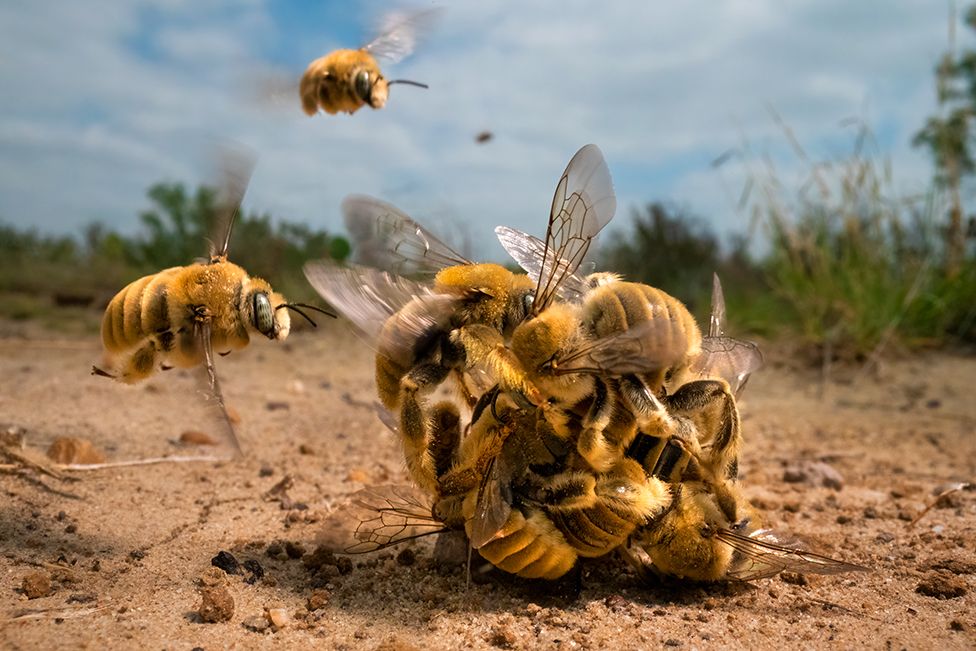ARTICLE AD BOX
 Image source, Karine Aigner/WPY
Image source, Karine Aigner/WPY
The big buzz: Karine Aigner's winning picture came at the end of several weeks of shooting
By Jonathan Amos
BBC Science Correspondent
It's a manic moment as male cactus bees envelop a single female. But who in this amorous scrum will emerge lucky and get to mate with her?
This remarkable picture, captured by Karine Aigner, is the grand title winner in this year's Wildlife Photographer of the Year competition.
On one level it's quite a technical image. It required the use of a macro probe lens to get in close to the very heart of the action.
"I had to spend quite a bit of time on my belly in the dirt," Karine joked.
The American is only the fifth woman to win the top prize in the 58-year history of WPY, as the competition is often called.
"It wasn't something I went looking for. I've been working on a ranch in South Texas for years, and I just happened on the location. I saw all these little 'volcanoes' in the ground - the individual burrows dug by the females to make their nests," she told BBC News.
Watch: Walking among the cactus bee nests. © Karine Aigner
Cactus bees, as their name suggests, live on and around cactus plants. The females collect pollen, which they fashion into small balls and store in chambers in the soil. The balls will sustain their larvae until they can surface as adults and continue the reproductive cycle.
"The picture is fabulous; it's got so much energy. It's a proper 'behaviour' shot. That's what you get from invertebrates and that's why I love them," said Roz Kidman Cox, who chairs the WPY judges.
"It's also the composition. What makes the photo complete are the bees coming in from the side. They give you 'the soundtrack'."
Image source, Katanyou Wuttichaitanakorn/WPY
Image caption,The beauty of baleen: Katanyou Wuttichaitanakorn went out in a boat 20-30 times to get this picture
The Young Wildlife Photographer of the Year for 2022 is Thailand's Katanyou Wuttichaitanakorn.
The 16-year-old's winning entry is a close-up of a Bryde's whale and the baleen plates in its mouth which are used to filter food.
You can see a sardine flying through the air as it tries to escape being gobbled down by the great cetacean.
"Somehow the sardine jumped in the boat," Katanyou recalled. "I was lucky. I got close in the boat and the whale stayed above the water for about a minute."
WPY is one of the most prestigious competitions of its type in world photography.
Started in 1964 by BBC Wildlife Magazine, the competition is now organised by London's Natural History Museum.
This year's event drew 38,575 entries from 93 countries. Below are some of the category winners.
Ndakasi's passing by Brent Stirton, South Africa
Image source, Brent Stirton/WPY
Brent Stirton is well known for his photojournalism, for which he is the WPY category winner this year. His picture shows the end of life of Ndakasi, a mountain gorilla who was rescued as a two-month-old after her troop was brutally killed by a powerful charcoal mafia in the DRC's Virunga National Park. Ndakasi is in the arms of her rescuer and caregiver, Andre Bauma.
Heavenly flamingos by Junji Takasago, Japan
Image source, Junji Takasago/WPY
These flamingos are pictured high in the Andes at Salar de Uyuni, the world's largest salt pan. It is also one of Bolivia's largest lithium mines, which threatens the future of the flamingos. Japanese photographer Junji Takasago suffered altitude sickness to get this image, but his discomfort won him the Natural Artistry category.
The dying lake by Daniel Núñez, Guetamala
Image source, Daniel Núñez/WPY
It may look colourful but this is not a healthy scene. Daniel Núñez used a drone to capture the contrast between the forest and the algal growth on the edge of Guatemala's Lake Amatitlán. The cyanobacteria in the water are driven by the presence of pollutants, such as sewage discharged from Guatemala City. The image won the Wetlands, The Bigger Picture category.
Shooting star by Tony Wu, USA/Japan
Image source, Tony Wu/WPY
Tony Wu caught this scene off the coast of Japan. It shows a giant sea star (starfish) at the moment of spawning. The echinoderm is moving its arms and swaying its body, perhaps to sweep eggs and sperm into the currents where they can fertilise together in the water. The image won WPY's Underwater category.
The bat-snatcher by Fernando Constantino Martínez Belmar, Mexico
Image source, Fernando Constantino Martínez Belmar/WPY
Fernando Constantino Martínez Belmar took this picture at a location known as the Cave of the Hanging Snakes. At dusk, thousands of bats leave the cave to forage for insects. As they depart, the rat snakes hang from the walls of the cave, aiming to get a meal of their own. The picture won the Behaviour: Amphibians and Reptiles category.
House of bears by Dmitry Kokh, Russia
Image source, Dmitry Kokh/WPY
Dimitry Kokh took this picture on Kolyuchin Island, which is in the Arctic's Chukchi Sea. The polar bears present a haunting scene in the fog that hangs over the abandoned buildings. Yachtsman Dimitry was on the island to take shelter from a storm. He used a small drone to get close to the predators. The picture won the Urban Wildlife category.
The annual exhibition dedicated to the WPY competition opens at the Natural History Museum in London on Friday. As in past years, it will also go on tour around the UK and to 10 countries worldwide. Entries for the 59th Wildlife Photographer of the Year will be accepted from Monday.

 2 years ago
44
2 years ago
44








 English (US) ·
English (US) ·